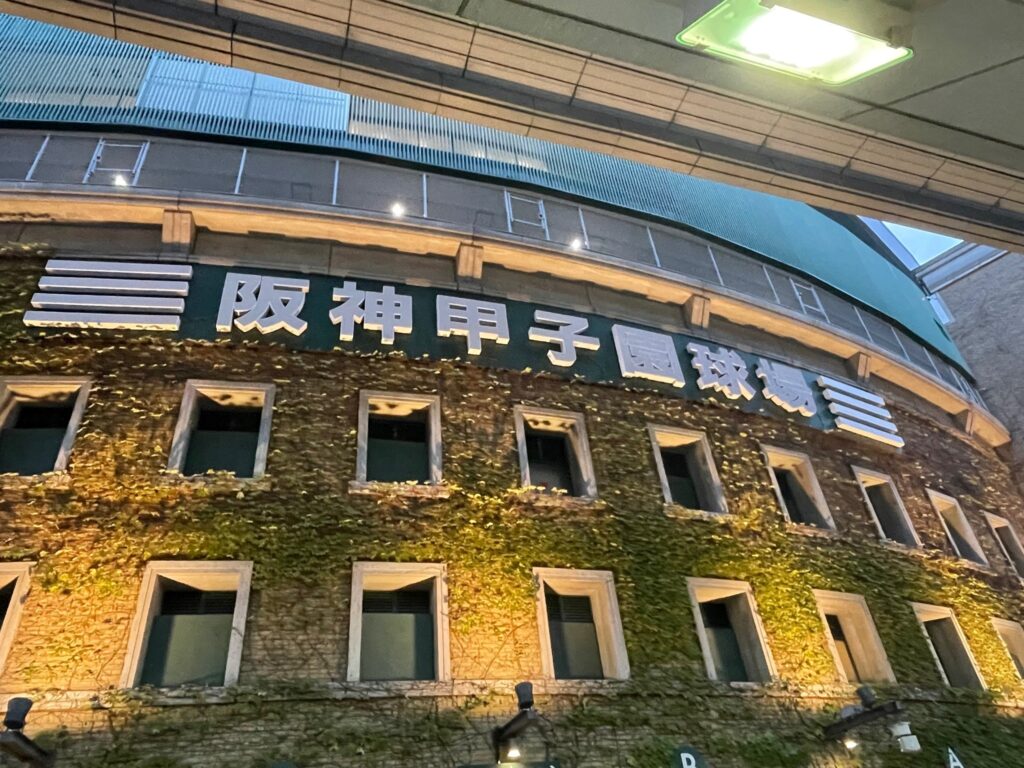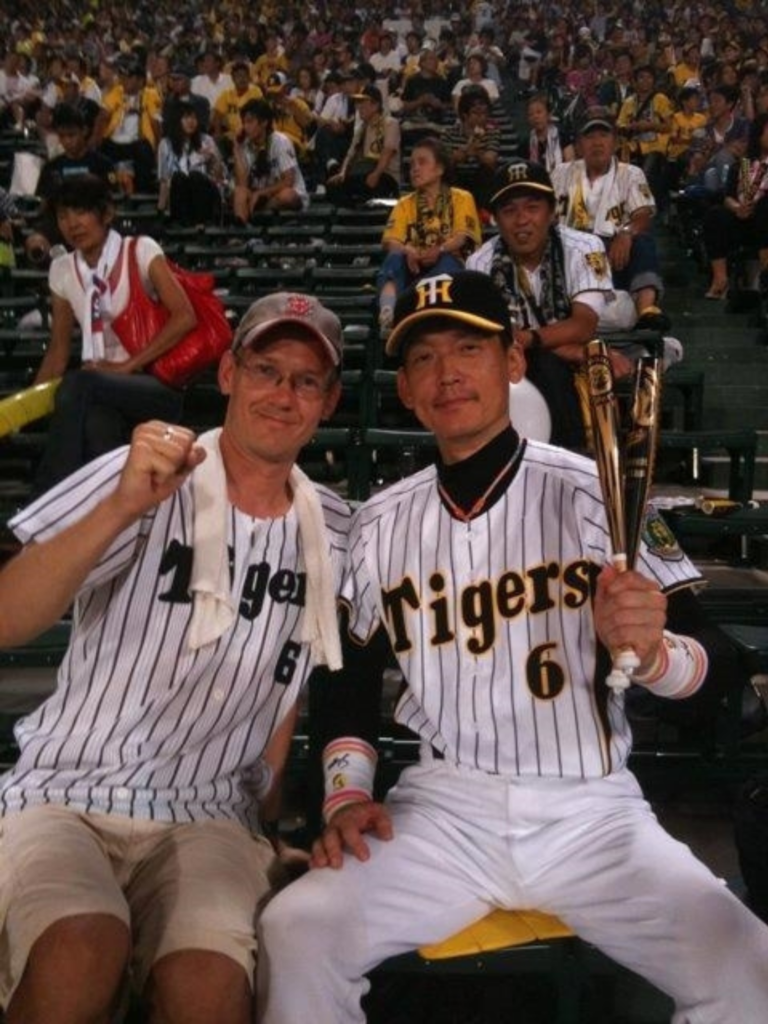Stepping up to the plate: Finding an unexpected home in Japan
As an introvert and small-town boy, what first drew me to Japan was the tranquility. Way back in the summer of 1994, as I was preparing to embark on my “one-year adventure” in Japan, I spent many hours leafing through travel and photo books about the country, trying to get a glimpse into the mysterious new life that awaited me. Monks deep in meditation at a mountaintop temple. Picture-perfect shrines surrounded by towering cedars. This side of Japan beckoned me, while pictures of Shibuya Crossing horrified me.
So, it was a great shock to me that the place where I came to most feel at home in Japan is one of the loudest and most festive spots in the whole country. I’m talking about a different type of shrine—Koshien Stadium, home to the Hanshin Tigers baseball team. Located between Kobe and Osaka in the city of Nishinomiya (Hyogo Prefecture), Koshien is the oldest baseball stadium in Japan. Opened in 1924 to host the national high school baseball tournaments, Koshien became home to the Tigers in 1936, the inaugural season of professional baseball in Japan.
But even more than the history, the atmosphere is what makes Koshien so special. Koshien also has the largest capacity of any baseball stadium in Japan, and nothing beats being in the middle of a sea of yellow and black, as 47,000 rabid fans passionately sing player’s songs, bang plastic bat noisemakers together, and cheer every hit like it’s a game-winning home run. It’s a baseball game and matsuri (festival) wrapped in one. After a long week of teaching classes, grading papers, and doing research, a Friday night game at Koshien has been the best way for me to unwind for the past 20 years.

To feel at home in a foreign country, it’s essential to find your “third place,” a place outside of work and home where you feel a sense of belonging and community. Koshien became my third place. But like many aspects of Japan, I didn’t immediately embrace the Japanese version of baseball. To explain that, we have to go back to the beginning.
First base: Checking out Japanese baseball
My first teaching job in Japan was in the city of Sapporo in Hokkaido, the northernmost of the four major islands. Although I came to Japan to seek new adventures, I also clung to the familiar, so I was happy to discover that baseball has long been the most popular team sport in Japan. Suishu Tobita, known as “the father of student baseball” in Japan, wrote that, “Baseball is more than just a game. Through it, one learns the beautiful and noble spirit of Japan.” Perfect. I could gain new insights into Japanese culture while watching the sport I had loved since I was a child.
Strike 1: Despite having the fifth largest population in Japan, back in those days, Sapporo did not yet have a professional baseball team, as it was still nearly 10 years before the Nippon Ham Fighters would relocate up north from Tokyo. Fortunately, one of the many wonderful points of Japanese baseball is that teams play occasional games in cities without a pro team. So, in the summer of 1995, I made my way to charming Maruyama Stadium to watch a game between the Seibu Lions and the Orix Blue Wave (featuring a baby-faced 21-year-old player who went by the name of Ichiro).
Strike 2: I simply did not enjoy the game as much as I had hoped to. I didn’t realize it (or admit it) at the time, but I was stuck in that nagging stage of cultural assimilation known as crisis or frustration. Although I had kidded myself into believing that living in a foreign country made me a completely open-minded global citizen, the hard truth is that I was stubbornly clinging to my own cultural mindset. Instead of just enjoying the Japanese version of my favorite sport, I found myself complaining about the differences with the American pastime.
Why do they bunt so much?
Why don’t they hit more home runs?
Why don’t they do the “7th inning stretch”?
Why can’t I get a hot dog?
Second base: Finding my team and my passion
I was behind in the count, but fortunately I didn’t strike out. While I continued to casually follow Japanese baseball, something was still missing. Perhaps what was missing is I still hadn’t found my team. It was hard to find a team to support when the nearest pro team was nearly 1,000 kilometers away from Sapporo.
That all changed when an Australian friend invited me to a Hanshin Tigers game in the summer of 1998. “You have to see this team,” he enthusiastically told me, “their fans are absolutely insane.” Even if I still wasn’t completely sold on Japanese baseball, I figured I at least needed to see these crazy fans in action. I’ve always been intrigued by the contrasts and exceptions in Japan. Since the prevailing cultural stereotype is that the Japanese are shy and reserved, I had to see what these “insane fans” were like.
Let’s just say the fans lived up to their reputation. And then some. After a thrilling come-from-behind victory that day, the party was just getting started. The loyal fans put on a spectacle outside the stadium after the game, passionately cheering and singing songs for what seemed like hours as if they had just won the Japan Series.
With fans this enthusiastic and loyal, I assumed the Tigers were a consistently strong team. Instead, they finished that season in the basement, a mere 27 games out of first place. In fact, the Tigers were in the middle of a remarkably horrible stretch of finishing as a B-class team (the moniker given to teams which finish in the bottom half of their six-team league) for 10 years in a row! Oddly enough, that made me embrace the Tigers (and their fans) even more.

Third base: Moving to Tiger territory
I became an instant Tigers fan after my first game in Sapporo, but seeing the Tigers play so far from their home base was just a tease. My next mission was to catch a game at the hallowed home stadium in Kansai. The baseball gods were against me. First attempt? Rained out. Second attempt? Cancelled because of a typhoon warning. As luck would have it, however, in the fall of 2004, I was offered a university teaching position right in Nishinomiya, a stone’s throw away from Koshien!
It didn’t take long after this move for Koshien to become my third place. And the cherry on top was that after the turn of the century, the Tigers suddenly emerged as a perennial A-class team. To my pleasant surprise, in 2005 (my first full season of watching games at Koshien), I could happily enjoy my time at my third place watching a first place team! I was admittedly a bit hesitant at first. In addition to being passionate, Tigers fans at that time also had a reputation for having a gritty side. Would they welcome some American fan who admired their passion yet still knew very little about the team and their history? They certainly did.

From my very first game at Koshien, I happily noticed that a fan is a fan and we’re all in this together. With every run scored, strangers gave each other high fives and banged their mini plastic bats together. When an American player hit a big home run, an older Japanese man even turned to me and said, “Thank you!”
Although I came completely unprepared for my first game, those around me enthusiastically welcomed me to the club. A fan on one side of me shared printouts of each player’s song with me so I could sing along.
During the middle of the 7th inning, I felt like the only person in the stadium (except the small postage stamp-sized section of visiting fans) who hadn’t brought a yellow balloon to blow up and then release at the culmination of the singalong of the Tigers’ theme song, “Rokko Oroshi” (literally “the downward winds of Mt. Rokko”), but a fan on the other side handed me a spare balloon. And another one later when we celebrated that night’s victory with another round of jet fusen.

Note that the tradition was discontinued during the pandemic.
Safe at home: Finding belonging through my passion
While it may seem like common sense, finding a passion for something in Japan, even if it just involved rooting for my (now) local baseball team, played a huge role in adapting to life here. Becoming a torakichi (“Tigers fanatic”) helped me much more rapidly graduate from soto (“outer group” or “outsider”) to uchi (“inner group”), a transition which can be easier said than done for foreign residents in Japan. As a foreigner here, we can be constantly confronted with the same conversation starters. Regardless of the good intentions, these questions can become terribly redundant.
Why did you come to Japan?
Can you use chopsticks?
Can you eat natto?
As my passion for and knowledge of the Tigers increased, I quickly discovered that I could instantly elevate small talk to, shall we say, Tiger talk. The previous questions were replaced by questions that instead showed two people sharing a passion regardless of nationality.
That was a great game last night, wasn’t it?
Who’s starting the game tonight?
Why can’t we beat the Giants?
Will we ever win it all? (more on that soon!)
I have now called the Kansai region of Japan home for the past 20 years. And I’ve seen over 100 games at Koshien. From temples to teahouses, from Okinawa to Hokkaido, I’ve visited countless places in this amazing country which brought me joy. But the happiest memories have involved screaming my head off with more than 40,000 other torakichi at my third place of Koshien Stadium.

When people asked me, “Aren’t you ever leaving Japan?” I used to joke that, “I can’t leave until the Tigers finally win the Japan Series again.” Well, that took much longer than anticipated, as 25 years passed from my first Tigers game at Maruyama Stadium until the Tigers finally won it all in 2023 (their first championship since 1985!). So I guess now I have to answer that, “I can’t leave until the Tigers win more championships than the Giants.” Considering that our Tokyo rival has won the Japan Series 22 times, it’s safe to say that I call Japan (and the Kansai region) home now.


I now agree even more with Tobita’s claim that “baseball is more than just a game.” But to me, even more than revealing “the beautiful and noble spirit of Japan,” baseball helped me find a sense of belonging and community in Japan.
